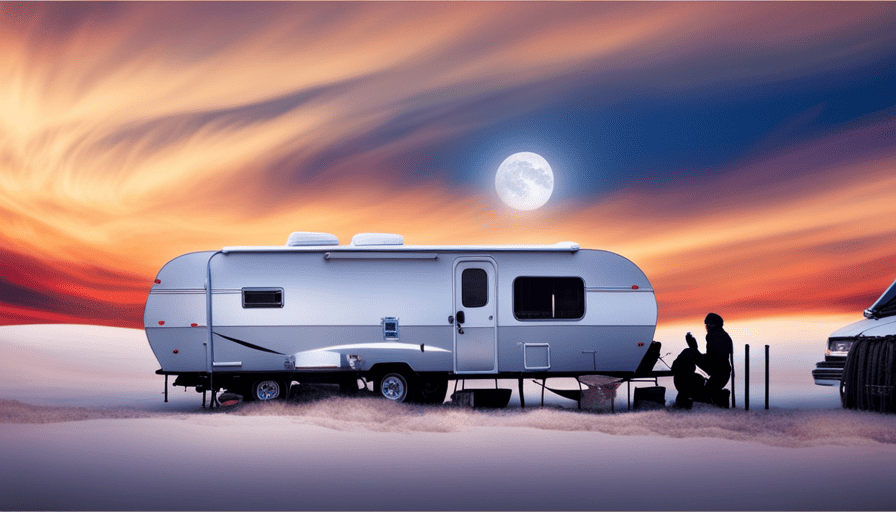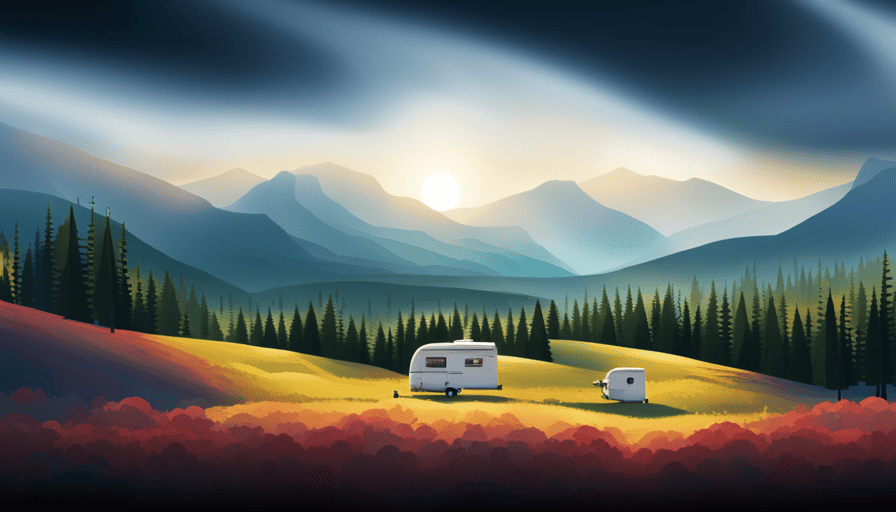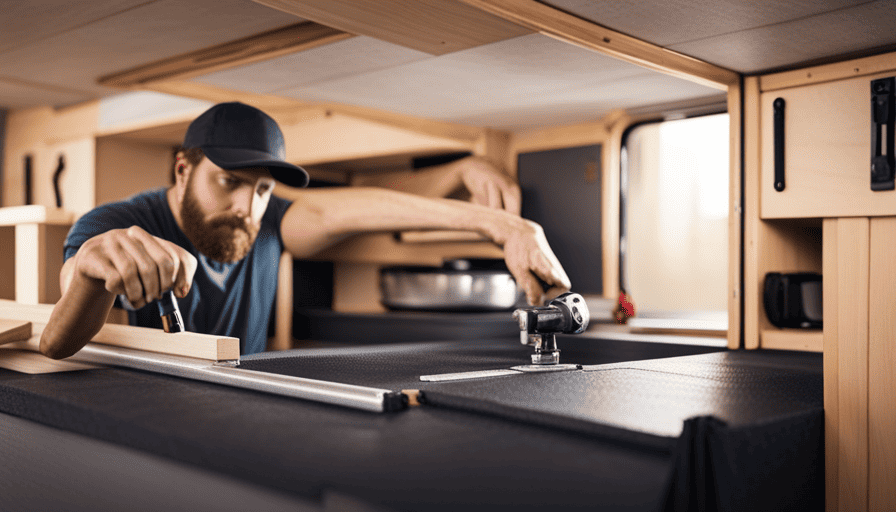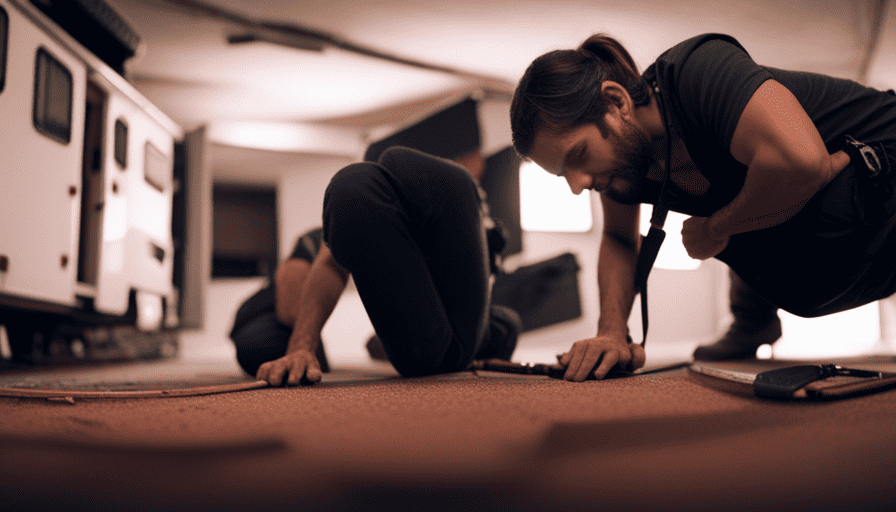Picture this: the first balmy day of spring arrives, and you’re eager to set out in your camper. However, before you can start your upcoming journey, there’s a crucial step you need to complete – getting your camper ready for spring after the winter.
This process involves preparing your camper after it has been stored during the winter months, ensuring that everything is in working order for your upcoming trips. In this article, I will guide you through the steps to de-winterize your camper, from draining and flushing the water system to testing the electrical system and checking the safety equipment.
By following these thorough and detailed instructions, you can ensure that your camper is ready to go when the open road beckons. So let’s get started and get your camper back in tip-top shape for your next unforgettable journey.
Key Takeaways
- Draining and flushing the water system is an important step in de-winterizing a camper.
- Testing the electrical system and checking safety equipment are crucial for a smooth camping experience.
- Inspecting tires and brakes, as well as checking the battery and testing the electrical system, are essential for camper readiness.
- Cleaning and restocking the interior, along with testing all appliances, ensure a comfortable and functional camping trip.
Drain and Flush the Water System
Now it’s time to drain and flush your water system, so you can get your camper ready for adventure! Flushing techniques and water system maintenance are essential to ensure a smooth camping experience.
Start by locating the drain valves, usually found underneath your camper. Open them one by one, starting with the furthest point from the fresh water tank. Allow the water to fully drain out, ensuring there’s no residue left.
Once drained, it’s time to flush the system. Connect a hose to the city water inlet and turn on the water supply. Open each faucet and let the water run for a few minutes to flush out any remaining debris. This step is crucial as it helps remove any contaminants and prevents clogs in the future. Don’t forget to flush the toilet as well!
After the system is thoroughly flushed, close all the faucets and drain valves. Now, it’s time to check and clean the exterior of your camper. A clean and well-maintained exterior not only improves the overall appearance but also prevents damage caused by dirt and grime.
Check and Clean the Exterior
To get started, take a moment to inspect and spruce up the outside of your recreational vehicle. The exterior maintenance of your camper is just as important as the interior, as it protects against wear and tear caused by the elements.
Here are some cleaning techniques to keep your camper looking its best:
-
Wash the exterior: Use a mild detergent and a soft brush to scrub away dirt and grime. Rinse thoroughly with water to ensure a squeaky-clean finish.
-
Clean the windows: Use a glass cleaner and a microfiber cloth to remove any streaks or smudges from the windows. Don’t forget to clean both the inside and outside of the windows for optimum visibility.
-
Polish and wax: After cleaning, apply a coat of polish or wax to protect the paint and give it a shiny finish. This will help prevent damage from UV rays and keep your camper looking new.
By following these cleaning techniques, you can maintain the exterior of your camper and prolong its lifespan.
Now, let’s move on to the next section and inspect the tires and brakes to ensure a safe and smooth journey.
Inspect the Tires and Brakes
Before we dive into inspecting the tires and brakes, let’s take a moment to ensure a safe and smooth journey for your recreational vehicle. Inspecting tire pressure and checking the brake fluid are crucial steps in preparing your camper for the road ahead.
First, let’s talk about tire pressure. It is important to check the pressure of each tire, including the spare, before hitting the road. Proper tire pressure ensures better fuel efficiency and reduces the risk of blowouts. Refer to the manufacturer’s guidelines to find the recommended pressure for your camper’s tires. Use a reliable tire pressure gauge to measure the pressure accurately. If the pressure is low, inflate the tires as needed.
Next, let’s move on to the brakes. Start by checking the brake fluid level. Locate the brake fluid reservoir, usually located near the engine bay. Ensure that the fluid is at the recommended level indicated on the reservoir. If it is low, add the appropriate brake fluid recommended by the manufacturer.
By inspecting tire pressure and checking the brake fluid, you are taking important steps to ensure your camper’s safety on the road. Now, let’s move on to the next section and test the electrical system.
Test the Electrical System
Let’s make sure your RV is ready to hit the road by testing its electrical system. Electrical troubleshooting and maintenance are essential to ensure that everything is in proper working order.
Start by inspecting the battery and checking for any signs of damage or corrosion. Clean the terminals and ensure they’re tightly connected. Next, test the battery voltage using a multimeter to ensure it’s within the recommended range.
Moving on, check all the interior and exterior lights to ensure they’re functioning correctly. This includes headlights, taillights, turn signals, and brake lights. Replace any burnt-out bulbs or damaged wiring as needed. Don’t forget to test the awning and slide-out mechanisms if your camper has them.
Additionally, check all the outlets and switches inside the RV. Plug in a device to each outlet to verify that power is flowing properly. If any outlets or switches aren’t working, it may be an issue with the circuit breaker or wiring, and further electrical troubleshooting may be needed.
To conclude, it’s crucial to thoroughly test the electrical system to guarantee a safe and enjoyable trip. Now that the electrical system is in good condition, let’s move on to checking the propane system and ensuring it’s ready to go without any issues.
Check the Propane System
Now that you’ve ensured your RV’s electrical system is in good working order, it’s time to check the propane system and make sure everything’s ready to go for your trip. Propane system maintenance is crucial for a safe and enjoyable camping experience.
Start by inspecting the propane tank for any signs of damage or leaks. Look for rust, dents, or loose fittings. If you notice any issues, it’s important to have them repaired before using the system.
Next, check the propane lines for any cracks or wear. Replace any damaged lines to prevent gas leaks.
Don’t forget to test the propane appliances, such as the stove, refrigerator, and water heater, to ensure they’re functioning properly. Ignite each appliance and check for a steady flame and proper heat output.
Safety’s paramount when dealing with propane, so make sure you have a working carbon monoxide detector installed in your camper. Additionally, familiarize yourself with the location of the propane shut-off valve in case of emergencies.
With the propane system checked and maintained, it’s time to clean and restock the interior for your upcoming trip.
Clean and Restock the Interior
After ensuring the propane system is in good working order, it is essential to clean and restock the interior of your RV for an enjoyable and hassle-free trip. Restocking supplies and organizing storage space are crucial steps to make sure you have everything you need and can easily find it when on the road.
To start, take inventory of your supplies and make a list of what needs to be replaced or replenished. This can include items like toiletries, cleaning products, kitchen essentials, and bedding. Once you have your list, head to the store and stock up on these necessities.
Next, it’s time to organize your storage space. Use bins or baskets to categorize items and keep them neatly arranged. Consider utilizing vertical space by using hanging organizers or shelves. This will maximize your storage capacity and make it easier to find what you need.
Lastly, give your RV a thorough cleaning. Begin by decluttering and removing any items that are no longer needed. Then, wipe down surfaces, vacuum the floors, and clean the windows. Don’t forget to sanitize the kitchen and bathroom areas, as well as the bedding.
Once your interior is clean and fully stocked, you’re ready to move on to the next step – testing the appliances.
Test the Appliances
Once you’ve cleaned and restocked your RV, it’s time to test out all the appliances to ensure they’re in working order. Appliance maintenance is crucial to a successful camping trip, so it’s important to take the time to troubleshoot any issues before hitting the road.
Here are some troubleshooting tips to help you along the way:
-
Check the refrigerator: Make sure it’s cooling properly by turning it on and setting it to the desired temperature. Listen for any unusual noises and ensure the door seals tightly.
-
Test the stove and oven: Turn on each burner to ensure they light up and produce a steady flame. For the oven, set it to the desired temperature and make sure it heats up properly.
-
Try out the water heater: Run hot water through both the kitchen and bathroom faucets to ensure the water heats up quickly and consistently.
Now that you’ve tested the appliances, it’s time to move on to the next step: checking the safety equipment.
Check the Safety Equipment
Before hitting the road, it’s important to ensure the safety equipment in your RV is in proper working order. Properly maintaining and storing safety equipment is essential for your camping trips.
One of the first things to check is the fire extinguisher. Make sure it’s fully charged and easily accessible. Check the expiration date and replace it if necessary.
Also, inspect the smoke and carbon monoxide detectors. Test them to ensure they’re functioning properly and replace the batteries if needed.
Next, inspect the emergency exit windows. Ensure they open and close smoothly and that the seals are intact.
It’s also crucial to check the condition of your first aid kit. Make sure it’s fully stocked with all the necessary supplies, including bandages, antiseptic ointment, and medications.
Additionally, inspect the electrical and propane systems for any signs of damage or leaks. Make sure all the connections are secure and there are no frayed wires. Check the propane detector to ensure it’s working correctly.
Properly maintaining and checking the safety equipment in your camper is vital for a safe and enjoyable camping experience.
Once you’ve completed this step, it’s time to move on to the next section and inspect and clean the plumbing system.
Inspect and Clean the Plumbing System
Now that you’ve ensured the safety equipment is in order, it’s time to dive into inspecting and cleaning the plumbing system. This will ensure a worry-free and refreshing camping experience.
Proper plumbing maintenance is crucial to avoid any issues during your trip. Start by checking all the water lines for leaks or damage. Make sure the faucets, showerheads, and toilets are all functioning properly. If you notice any leaks or issues, it’s best to address them before hitting the road.
Next, it’s important to clean the entire plumbing system. Begin by flushing the freshwater tanks to remove any residue or contaminants that may have accumulated over the winter. You can use a mixture of water and vinegar to clean the tanks thoroughly. Don’t forget to clean the water heater as well, following the manufacturer’s instructions.
Additionally, don’t overlook the importance of water filtration. Installing a water filtration system will ensure that the water you use for cooking, drinking, and showering is clean and safe. There are various options available, including inline filters and countertop filters. Choose one that suits your needs and install it in the camper.
With the plumbing system inspected and cleaned, you’re one step closer to a successful camping trip. In the next section, we will discuss how to prepare for your first trip without any hassle.
Prepare for Your First Trip
Get ready for an unforgettable adventure as you embark on your first camping trip, where endless possibilities and amazing memories await. Before you hit the road, it’s important to make sure you have everything you need.
Here’s a handy camping checklist to help you pack your essentials:
- Tent: Make sure you have a sturdy and waterproof tent that can accommodate everyone in your group.
- Sleeping bags and sleeping pads: Stay warm and comfortable with good quality sleeping bags and sleeping pads.
- Cooking supplies: Don’t forget to bring a camping stove, pots, pans, utensils, and a cooler to keep your food fresh.
- Outdoor gear: Pack appropriate clothing layers, hiking boots, a backpack, and other outdoor essentials like a compass, flashlight, and insect repellent.
As you prepare for your first camping trip, it’s important to remember that being well-prepared is key to having a successful and enjoyable experience. Take the time to create a camping checklist and make sure you have all the necessary items packed and ready to go. By being thorough and organized, you’ll be able to relax and fully immerse yourself in the beauty of nature.
So, grab your gear, gather your friends or family, and get ready for a camping adventure like no other!
Frequently Asked Questions
How often should the tires be inspected and replaced on a camper?
Tire maintenance is crucial for camper safety. Regular inspections are recommended to check for tread wear, cracks, and bulges. I suggest inspecting your camper’s tires at least once a month or before long trips.
Additionally, it’s essential to replace the tires when they show signs of significant wear or damage. Remember to always consult the manufacturer’s guidelines and follow proper tire inflation to ensure optimal performance and longevity.
What safety equipment should be checked before using a camper?
When it comes to safety equipment maintenance for your camper, it’s absolutely crucial to check everything before hitting the road. A thorough safety equipment checklist should include inspecting fire extinguishers to make sure they’re not just decorative paperweights. It’s also important to test smoke and carbon monoxide detectors to ensure they’re not just fancy noisemakers. Additionally, checking emergency exits is necessary to guarantee they’re not just ornamental decorations. Remember, nothing says ‘I care about safety’ like functioning safety equipment. Don’t leave home without it!
How frequently should the plumbing system be cleaned and maintained in a camper?
The plumbing system in a camper should be cleaned and maintained regularly to ensure proper functioning. It’s recommended to clean the system at least once every season or every 3-6 months. This helps prevent clogs and keeps the water flowing smoothly.
Additionally, it’s important to regularly inspect and replace any worn out or damaged parts to avoid leaks and other plumbing issues. Following a consistent camper plumbing cleaning schedule will help keep your system in good condition and extend its lifespan.
Can appliances in a camper be used while it is in motion?
Yes, appliances in a camper can be used while it’s in motion. However, it’s important to take safety precautions. Make sure all appliances are securely fastened or turned off before hitting the road. Avoid using appliances that require an open flame, such as stoves or ovens, as they can be dangerous while the camper’s moving. Additionally, always follow the manufacturer’s instructions and guidelines to ensure the safe operation of appliances while on the go.
What are some common electrical issues to look out for in a camper?
When it comes to common electrical problems in campers, there are a few issues you should be aware of.
One common issue is a blown fuse, which can cause certain appliances or lights to stop working.
Another problem is a faulty circuit breaker, which can trip and cut off power to specific areas of the camper.
Troubleshooting electrical issues typically involves checking fuses, circuit breakers, and connections for any signs of damage or loose connections.
Can De-Winterizing a Camper Help Prevent Carbon Monoxide Buildup?
De-winterizing a camper is vital to prevent carbon monoxide buildup. Neglected campers can have blocked vents or malfunctioning appliances that lead to a hazardous situation. Proper maintenance and inspections can identify potential carbon monoxide in camper causes, ensuring a safe and enjoyable camping experience. Stay vigilant to protect yourself and loved ones.
Conclusion
In conclusion, de-winterizing a camper requires a thorough and detailed approach. By draining and flushing the water system, checking and cleaning the exterior, inspecting the tires and brakes, testing the electrical system, checking the propane system, testing the appliances, checking the safety equipment, inspecting and cleaning the plumbing system, and preparing for your first trip, you can ensure that your camper is ready to hit the road.
Remember, taking these steps will not only prolong the life of your camper but also ensure a safe and enjoyable camping experience. Happy travels!











